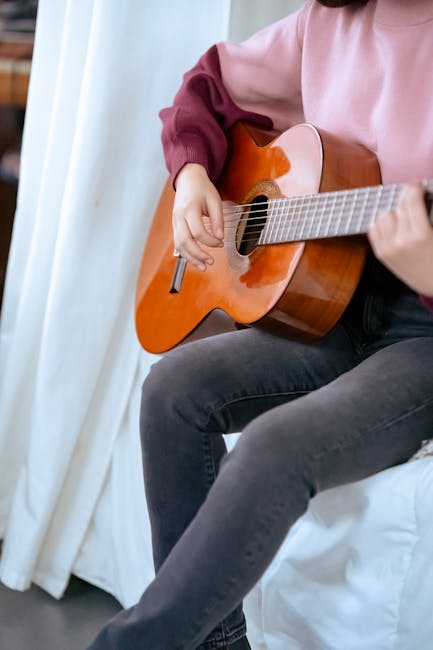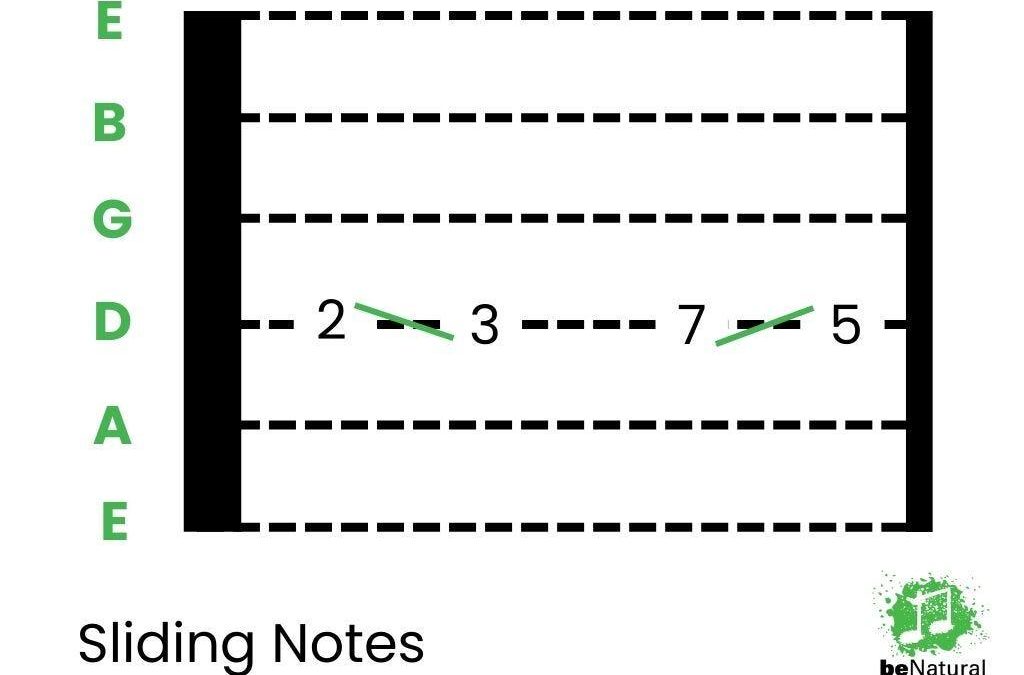guitar-pick-keeps-slipping/” title=”5 Questions to Ask Yourself if Guitar Pick Keeps Slipping”>Strumming your way into the world of guitar playing can be a daunting task, especially when faced with the mysterious hieroglyphics of guitar tabs and notation. But fear not, my fellow aspiring rockstars! In this beginner’s guide, we’ll decode the musical matrix of strings, frets, and squiggly lines to help you unlock the secrets of rocking out like a pro. So grab your guitar, dust off those rusty chords, and get ready to unleash your inner guitar god or goddess – one fret at a time!
Contents
- 1 The Evolution of Guitar Tabs and Musical Notation
- 2 Deciphering the Symbols in Guitar Tabs
- 3 Transitioning from Standard Notation to Guitar Tabs
- 4 Mastering Rhythmic Notation in Guitar Music
- 5 Exploring Advanced Techniques Through Guitar Tabs
- 6 Incorporating Expression and Dynamics into Your Playing
- 7 Common Pitfalls and Tips for Effective Practice
- 8 FAQs
- 9 Rock on, Beginner Guitarists!
The Evolution of Guitar Tabs and Musical Notation
As musicians, we’ve come a long way from drawing stick figures and squiggly lines on parchment to convey our musical ideas. Guitarists, in particular, have benefited from . Let’s take a walk down memory lane and explore how we went from hieroglyphics to digital tabs.
Back in the days of yore, musicians communicated through a series of grunts, groans, and interpretive dance. It wasn’t until the invention of the printing press that musical notation began to take shape. Imagine trying to decipher a piece of sheet music while dodging angry villagers hurling pitchforks at you for hogging the “sheet music”! Thankfully, the invention of the staff and notes made it a tad easier for musicians to share their compositions.
Fast forward to modern times where guitar tabs reign supreme. With just six strings and a few numbers, you can play your favorite song without breaking a sweat (or a string, hopefully). It’s like being handed the key to a mystical realm filled with power chords, arpeggios, and the occasional face-melting solo. Who needs sheet music when you’ve got bold numbers and sleek lines guiding your fingers along the fretboard?
So next time you’re shredding on your guitar, spare a thought for the humble beginnings of guitar tabs and musical notation. From stone tablets to interactive apps, we’ve come a long way, baby. Keep on rocking and rolling, fellow guitarists!
Deciphering the Symbols in Guitar Tabs
So you’ve picked up your guitar, found a song you want to learn, but then you come across those cryptic symbols in guitar tabs. Fret not, dear rockstar-in-training, for we are here to help you crack the code of these mystical markings!
First up, that weird “h” you keep seeing all over the tabs? No, it’s not a secret love letter. It actually stands for hammer-on, where you use your fretting hand to quickly hammer down on a string to produce a note without picking it. It’s like giving your guitar a little tap on the shoulder, saying “Hey, play this note without me.”
Next culprit on our list is the dreaded “p”. No, it’s not a typo for “play” or “pick”. It actually signifies a pull-off, where you pluck a string and then use your fretting hand to remove your finger quickly, creating a new note without the help of your pick. It’s like magic, but with more calluses on your fingertips.
And let’s not forget about the sneaky “/” and “” symbols in those tabs. These little guys are known as slides, where you gracefully glide your finger up or down the fretboard to smoothly transition between notes. It’s like the guitar equivalent of a fancy dance move, but with more potential for accidentally muting strings.

Transitioning from Standard Notation to Guitar Tabs
So, you’ve finally decided to make the switch from standard notation to guitar tabs. Congratulations! This is a big step in your musical journey, and one that will open up a whole new world of possibilities for you as a guitarist.
One of the biggest benefits of using guitar tabs is that they are much easier to read and interpret than traditional sheet music. With standard notation, you have to remember all those pesky sharps, flats, and key signatures. But with tabs, all you need to know is where to put your fingers on the fretboard - it’s like playing a musical game of connect the dots!
Remember, learning to read guitar tabs is like learning a new language. It may take some time to get the hang of it, but with practice and patience, you’ll soon be fluent in the language of guitar. And hey, if all else fails, you can always resort to the age-old guitarist trick of pretending you know what you’re doing and hoping for the best!
So embrace the transition from standard notation to guitar tabs with open arms – it’s a journey worth taking. And who knows, you may just discover a whole new level of musical gratification that you never knew existed. Rock on!

Mastering Rhythmic Notation in Guitar Music
Ready to dive headfirst into the world of rhythmic notation in guitar music? It might seem overwhelming at first, but fear not! With a little practice and a lot of patience, you’ll be a master in no time.
Here are a few tips to help you on your journey:
- Start slow: Don’t rush into complex rhythms right away. Take your time to perfect the basics before moving on to more advanced techniques.
- Use a metronome: This little device is your best friend when it comes to mastering rhythm. Start slow, gradually increasing the tempo as you get more comfortable.
- Practice, practice, practice: Like any skill, rhythm notation takes time to perfect. Set aside dedicated practice time each day to work on your rhythm.
Don’t be afraid to make mistakes along the way. Remember, even the greatest guitar players had to start from the beginning at some point. Embrace the process and have fun with it!

Exploring Advanced Techniques Through Guitar Tabs
So you’ve mastered the basic chords and are ready to take your guitar skills to the next level through some advanced techniques using guitar tabs. Get ready to impress your friends and family with your newfound musical prowess!
First, let’s talk about the power of bends. Bends can add emotion and character to your playing, but they can be a bit tricky to master. Start by slowly bending the string with your fretting hand while picking the note with your strumming hand. Practice makes perfect, so don’t get discouraged if it takes some time to get it just right!
Next up, let’s delve into the world of hammer-ons and pull-offs. These techniques involve using your fingers to quickly press and release the strings without picking them. This creates a smooth and fluid sound that will take your playing to a whole new level. Experiment with different combinations and patterns to really showcase your skills.
And finally, don’t forget about slides. Slides involve moving your fretting hand up or down the neck of the guitar while maintaining pressure on the string. This can create a cool, sliding effect that adds a unique flair to your playing. Try incorporating slides into your solos and see how they can enhance your overall sound.
Incorporating Expression and Dynamics into Your Playing
So you want to take your playing to the next level and really make your music come alive? Well, it’s time to incorporate expression and dynamics into your playing! Here are some tips to help you master this essential skill:
First off, it’s important to really connect with the music emotionally. Get into the groove and let your feelings guide your playing. Whether you’re feeling joyful, melancholic, or downright angry, let that emotion shine through in your music.
Next, don’t be afraid to experiment with different dynamics. Play around with volume levels, from soft and gentle to loud and powerful. This will add depth and variety to your playing, keeping your listeners engaged and on their toes!
Finally, don’t forget to use techniques like vibrato, slides, and bends to add flair and personality to your playing. These small touches can make a world of difference in how your music is perceived, so don’t be afraid to get creative!
Common Pitfalls and Tips for Effective Practice
When it comes to practicing effectively, there are a few common pitfalls that many musicians fall into. One big mistake is practicing too quickly and making mistakes along the way. Remember, slow and steady wins the race!
Another common pitfall is practicing for too long without taking breaks. Your brain needs time to rest and absorb the information you’re feeding it. So, make sure to schedule in some snack breaks or dance parties to keep things fun!
One tip for effective practice is to break up your practice session into shorter, focused chunks. This helps keep your brain engaged and prevents burnout. Plus, you can reward yourself with a little treat after each successful chunk – like a high-five or a piece of chocolate!
Lastly, don’t forget to mix things up and keep your practice sessions interesting. Try practicing in different rooms, at different times of day, or even with different instruments. Your brain loves a challenge, so keep it on its toes!
FAQs
How do I read guitar tabs?
Think of guitar tabs as a cheat sheet for playing your favorite songs. Each line represents a string on the guitar, and the numbers on the lines represent which fret to press down. It’s like reading a secret code, but for rocking out instead of spying.
What’s the difference between guitar tabs and standard notation?
Standard notation is like reading a complex math equation, with all the notes and rhythms meticulously laid out. Guitar tabs, on the other hand, are more like a doodle on the back of your notebook that somehow gives you the key to shredding like a rock god.
Why should I bother learning how to read guitar tabs?
Well, if you want to impress your friends with your ability to play their favorite songs, then tabs are your ticket to fame and glory. Plus, it’s a lot easier than trying to decipher musical hieroglyphics. Just saying.
Are there any symbols or techniques I should know about when reading guitar tabs?
Absolutely! Look out for bend symbols, slides, hammer-ons, pull-offs, and palm muting. These are the secret weapons that will take your guitar playing to the next level and make you the envy of every guitarist in the neighborhood.
How can I practice reading guitar tabs effectively?
Start by picking a simple song and practicing a little bit every day. Soon enough, you’ll be able to read tabs faster than you can say “Stairway to Heaven.” Well, maybe not that fast, but you get the idea.
Rock on, Beginner Guitarists!
Congratulations on making it through our beginner’s guide to understanding guitar tabs and notation. Now that you’re armed with this knowledge, you’ll be shredding like a pro in no time! Remember, practice makes perfect, so keep those fingers limber and those strings strumming. Soon enough, you’ll be the envy of all your friends at the next campfire jam session.
So go forth, young rockstar, and make some beautiful music. And always remember: when in doubt, just play it loud!



